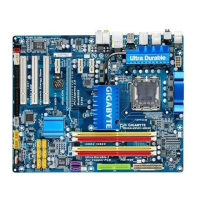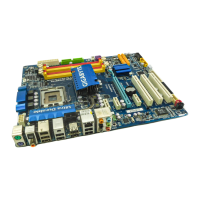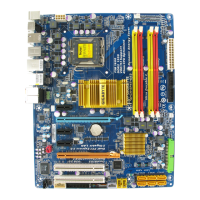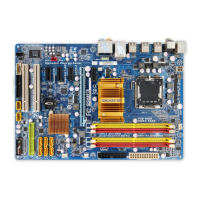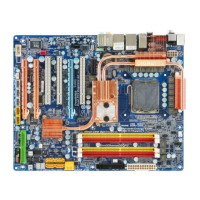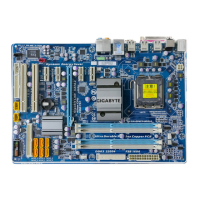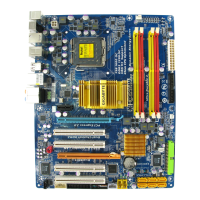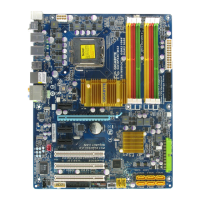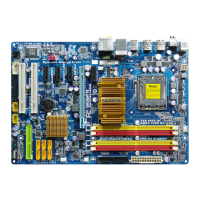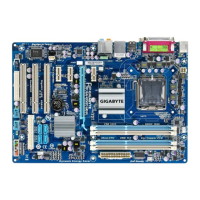Do you have a question about the Gigabyte GA-EP45-UD3LR and is the answer not in the manual?
Essential safety guidelines and procedures to follow before installing hardware to prevent damage.
Comprehensive list of technical details and features of the motherboard.
Step-by-step instructions for correctly installing the central processing unit and its cooling solution.
Detailed guide on how to properly install RAM modules into the motherboard slots.
Procedure for inserting and securing expansion cards into available slots on the motherboard.
Identification and description of external ports and connectors on the motherboard's rear panel.
Explanation of various internal headers and pinouts on the motherboard for system components.
Overview of the screens displayed during system startup and key function assignments.
Introduction to the BIOS Setup interface, main menu options, and navigation controls.
Settings for advanced system tuning, including CPU frequency, voltages, and memory timings.
Basic system configuration for date, time, and primary hardware detection settings.
Options for configuring boot order, system security, and other advanced hardware features.
Configuration and management of onboard devices like SATA, USB, LAN, and audio controllers.
Settings related to ACPI states, power button behavior, and wake-up events.
Management of Plug and Play resources and IRQ assignments for PCI slots.
Monitoring of system voltages, temperatures, and fan speeds for optimal operation.
Restoring BIOS settings to the safest, most stable factory defaults.
Restoring BIOS settings to the optimal factory defaults for performance.
Options for setting and managing BIOS access passwords for system security.
Saving current BIOS configurations and exiting the setup utility.
Exiting the BIOS setup without applying any changes made during the session.
Step-by-step guide for installing the essential chipset drivers for motherboard functionality.
Information on installing GIGABYTE's bundled utilities and other provided software applications.
Accessing application guides, content descriptions, and motherboard manuals from the driver disk.
Contact information and support links for GIGABYTE customer service and technical assistance.
Displays basic system information derived from the installed hardware and software.
Provides links to the GIGABYTE website for downloading the latest BIOS, drivers, and applications.
Utility to quickly compress, back up, and restore system data on the primary hard drive.
Tools like Q-Flash and @BIOS for updating the motherboard's BIOS safely and easily.
Software for fine-tuning system performance, overclocking, and managing fan speeds within Windows.
Technology for optimizing power consumption and enhancing energy efficiency through hardware/software.
A tool that facilitates easy data sharing between computers on the same network.
A utility leveraging Volume Shadow Copy Services for backing up and restoring system data.
Guide for setting up SATA hard drives, including RAID configurations and driver installation.
Instructions for setting up and using the motherboard's audio jacks for various channel configurations.
Common questions and a step-by-step procedure to resolve system startup and hardware issues.
Important legal, safety, and environmental compliance information regarding the product.
Essential safety guidelines and procedures to follow before installing hardware to prevent damage.
Comprehensive list of technical details and features of the motherboard.
Step-by-step instructions for correctly installing the central processing unit and its cooling solution.
Detailed guide on how to properly install RAM modules into the motherboard slots.
Procedure for inserting and securing expansion cards into available slots on the motherboard.
Identification and description of external ports and connectors on the motherboard's rear panel.
Explanation of various internal headers and pinouts on the motherboard for system components.
Overview of the screens displayed during system startup and key function assignments.
Introduction to the BIOS Setup interface, main menu options, and navigation controls.
Settings for advanced system tuning, including CPU frequency, voltages, and memory timings.
Basic system configuration for date, time, and primary hardware detection settings.
Options for configuring boot order, system security, and other advanced hardware features.
Configuration and management of onboard devices like SATA, USB, LAN, and audio controllers.
Settings related to ACPI states, power button behavior, and wake-up events.
Management of Plug and Play resources and IRQ assignments for PCI slots.
Monitoring of system voltages, temperatures, and fan speeds for optimal operation.
Restoring BIOS settings to the safest, most stable factory defaults.
Restoring BIOS settings to the optimal factory defaults for performance.
Options for setting and managing BIOS access passwords for system security.
Saving current BIOS configurations and exiting the setup utility.
Exiting the BIOS setup without applying any changes made during the session.
Step-by-step guide for installing the essential chipset drivers for motherboard functionality.
Information on installing GIGABYTE's bundled utilities and other provided software applications.
Accessing application guides, content descriptions, and motherboard manuals from the driver disk.
Contact information and support links for GIGABYTE customer service and technical assistance.
Displays basic system information derived from the installed hardware and software.
Provides links to the GIGABYTE website for downloading the latest BIOS, drivers, and applications.
Utility to quickly compress, back up, and restore system data on the primary hard drive.
Tools like Q-Flash and @BIOS for updating the motherboard's BIOS safely and easily.
Software for fine-tuning system performance, overclocking, and managing fan speeds within Windows.
Technology for optimizing power consumption and enhancing energy efficiency through hardware/software.
A tool that facilitates easy data sharing between computers on the same network.
A utility leveraging Volume Shadow Copy Services for backing up and restoring system data.
Guide for setting up SATA hard drives, including RAID configurations and driver installation.
Instructions for setting up and using the motherboard's audio jacks for various channel configurations.
Common questions and a step-by-step procedure to resolve system startup and hardware issues.
Important legal, safety, and environmental compliance information regarding the product.
| Number of memory slots | 4 |
|---|---|
| Processor socket | LGA 775 (Socket T) |
| Processor manufacturer | Intel |
| USB 2.0 connectors | 2 |
| Power fan connector | Yes |
| Number of SATA connectors | 6 |
| Controller interface type | SATA |
| Controller 2nd interface type | ATA-133/100/66/33 |
| Headphone outputs | 3 |
| USB 2.0 ports quantity | 8 |
| Firewire (IEEE 1394) ports | 0 |
| Audio chip | Realtek ALC888 |
| Audio output channels | 7.1 channels |
| Motherboard form factor | ATX |
| Compatible operating systems | Microsoft/ Windows/ Vista/XP |
| LAN controller | Realtek RTL8111C |
| Depth | 210 mm |
|---|---|
| Width | 305 mm |
